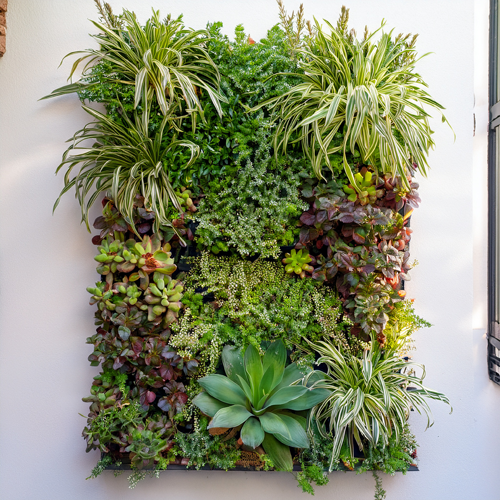Vertical garden aren’t just a creative trend—they’re a practical solution for anyone dealing with limited outdoor space. Whether you live in an apartment, manage a rooftop terrace, or want to add greenery to a narrow patio, vertical gardening transforms small areas into lush green retreats.
In this guide, you’ll discover the benefits of vertical gardens, the best designs for compact spaces, the ideal plants to grow, and step-by-step ideas to create your own vertical oasis.

What Is a Vertical Garden?
A vertical garden is any arrangement of plants grown vertically, often against walls, fences, or freestanding structures. These gardens can be purely decorative or functional—used to grow herbs, vegetables, or flowers in tight areas.
Common types include:
- Wall-mounted planters
- Hanging baskets and pots
- Living walls (green walls)
- Pocket gardens made of felt or fabric
- Recycled pallet or ladder structures
They’re widely used in urban landscaping to maximize greenery without sacrificing floor space.
Why Vertical Gardens Matter
Whether you’re a homeowner, renter, or landscape designer, vertical gardens offer more than just good looks:
1. Space Optimization for vertical garden
Ideal for balconies, patios, terraces, and side yards where horizontal space is limited.
2. Eco-Friendly Living
Improves air quality, provides insulation, and reduces urban heat with a low carbon footprint.
3. Aesthetic Upgrade
Turns blank walls into living art and boosts curb appeal instantly.
4. Customizable & Scalable – vertical garden
From DIY kits to large-scale installations, vertical gardens adapt to your style, budget, and available space.
Best Vertical Garden Ideas for Small Spaces

1. Wall-Mounted Planters
Attach ceramic, wooden, or metal planters directly onto a wall or fence. Group different sizes and colors for visual interest. Ideal for herbs, succulents, or flowers.
2. Hanging Pots and Baskets
Suspend pots from pergolas, balcony ceilings, or shelves. This method adds depth and texture to small courtyards or entryways.
3. Pallet Gardens

Repurpose old wooden pallets by filling the slats with soil and inserting plants. Perfect for rustic charm and DIY gardening.
4. Vertical Garden Kits and Trellis Systems
Available online or in stores, these modular systems often come with watering trays, making them beginner-friendly and efficient.
5. Pocket Planters (Felt or Fabric Walls)
Lightweight and easy to install, these hanging systems are great for herbs, strawberries, and flowers. They allow good drainage and air circulation.
6. Ladder or Stair-Step Planters
Lean a painted wooden ladder against a wall and place potted plants on each step. Great for a mobile and flexible display.
7. Freestanding Green Walls
Use wooden or metal frames with climbing plants or pot holders. These can serve as privacy screens or decorative dividers on patios.
Best Plants for Vertical Garden
Choose plants based on light conditions, maintenance level, and design goals. Here are top picks:
- Herbs: Basil, thyme, mint, parsley
- Succulents: Echeveria, sedum, jade
- Flowers: Petunia, marigold, pansy
- Vines: Pothos, ivy, creeping fig
- Vegetables: Lettuce, spinach, cherry tomatoes (with support)
Consider mixing trailing, upright, and compact plants for variety and coverage.
How to Build a Vertical Garden
1. Define the Location and Purpose
Choose a wall, railing, or freestanding structure. Decide if it’s decorative, edible, or both.
2. Plan the Layout
Sketch your design, accounting for light exposure, water access, and plant size.
3. Prepare the Materials for your vertical garden
Gather planters, mounting tools, soil, and irrigation if needed. Use breathable containers with drainage.
4. Install the Structure
Secure your planters or vertical frame. Test for stability and weight capacity.
5. Plant & Water
Use lightweight potting mix. Water thoroughly and regularly, especially for upper levels exposed to wind or sun.
6. Maintain with Care
Prune dead leaves, check for pests, and fertilize monthly. Consider a drip irrigation system for convenience.
Vertical Garden vs Traditional Garden Beds
| Feature | Vertical Garden | Traditional Garden Bed |
|---|---|---|
| Space Use | Minimal | Requires more ground |
| Aesthetic | Modern & artistic | Classic & sprawling |
| Maintenance | Easier access, low weed growth | May need more bending and upkeep |
| Sunlight Use | Optimized with tiers | Depends on full bed location |
| Versatility | Indoor, outdoor, balcony, wall | Outdoor only |
Sustainability and Urban Impact
Vertical gardens aren’t just beautiful—they contribute to greener, cooler, and more breathable cities. In public settings, they:
- Absorb pollutants and CO₂
- Provide habitats for insects and birds
- Reduce building energy use through insulation
- Enhance community spaces with green aesthetics
Cities around the world—from Singapore to London—use vertical gardens in rooftops, hotels, restaurants, and even parking lots to create living infrastructure.

Final Thoughts – Vertical Garden
Vertical gardens are smart, stylish, and sustainable. They turn small or underused spaces into thriving green corners without compromising design. Whether you’re an urban gardener, a DIY enthusiast, or a landscape professional, there’s a vertical gardening solution that fits your vision.
With a bit of creativity and care, your walls can come alive — and your garden can grow vertically toward beauty and function.
Check out our article “Modern Garden Lighting Ideas” for tips on how to highlight your vertical garden at night.


